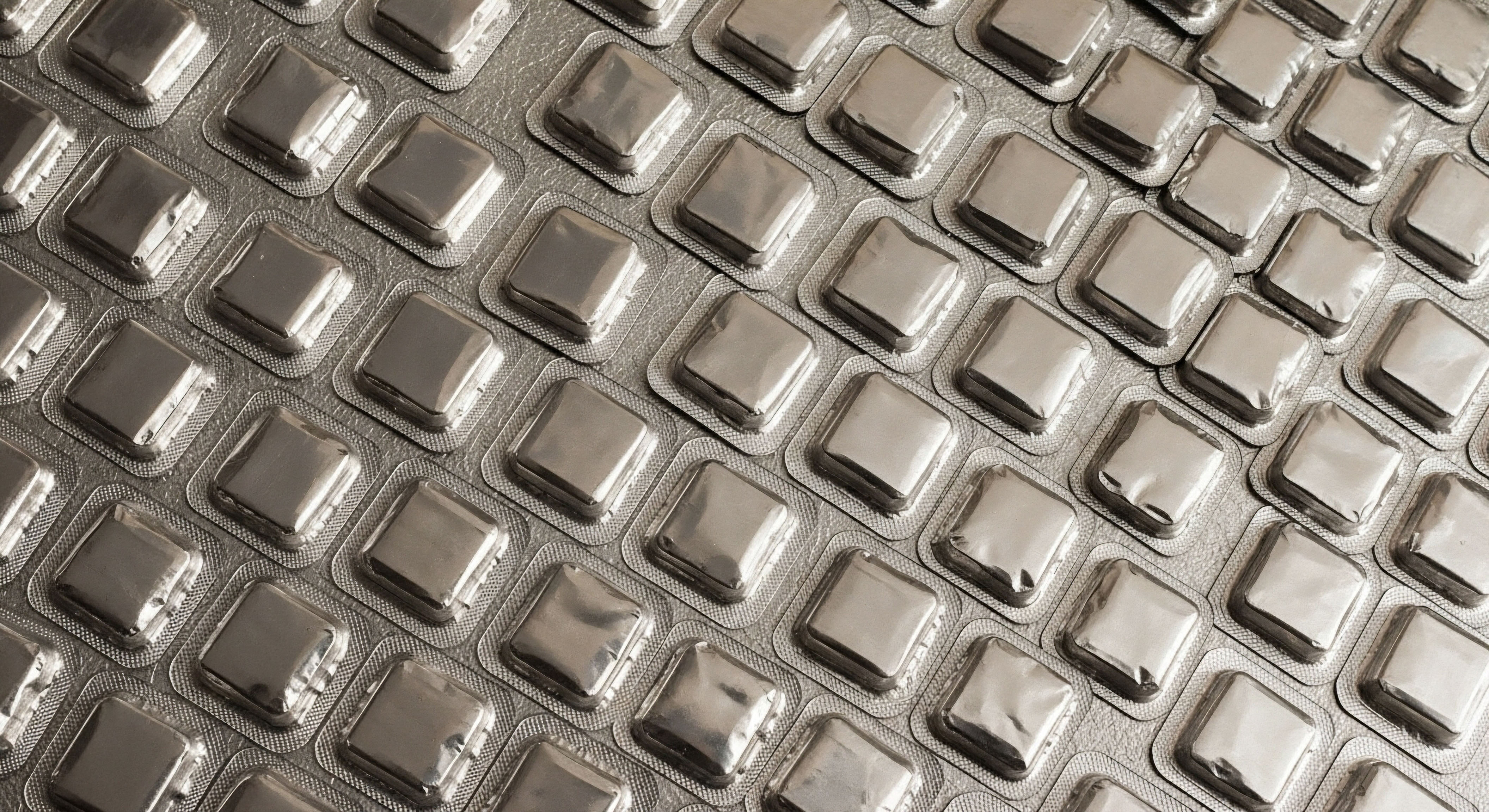

Fundamentals
You are here because the way you feel is misaligned with the performance you are expected to deliver. A persistent fatigue has settled deep in your bones, a cognitive fog clouds your focus, and the drive that once defined your professional life has become muted.
You ask, “Can lifestyle changes alone restore what has been lost?” This question is born from a deeply personal and valid experience. It points toward a fundamental truth about human biology ∞ our internal state dictates our external capacity. The answer begins with understanding the elegant, intricate system of communication that governs your body’s resources ∞ the endocrine system.
Think of your body as a highly sophisticated corporation. Your hormones are the messengers, the critical communications that flow between the executive leadership in the brain and the operational departments ∞ your organs, tissues, and cells. These messages dictate energy expenditure, resource allocation, mood, and metabolic rate.
When this communication system is functioning optimally, resources are deployed efficiently, and performance is high. When the signals become distorted, delayed, or degraded, the entire operation begins to lag. The fatigue and diminished output you experience are the tangible results of this internal communication breakdown. Restoring function requires us to first repair the signaling pathways. This work starts with the most powerful inputs you control every day.
The quality of your sleep directly orchestrates the daily ebb and flow of hormones essential for energy, recovery, and stress management.

The Biological Mandate of Sleep
Your body’s most critical hormonal regulation and recovery processes occur during sleep. This period of rest is an active, highly structured state of regeneration. The architecture of your sleep, cycling through light, deep, and REM stages, is a direct determinant of your hormonal health.
Deep sleep, for instance, is the primary window for the release of growth hormone, the body’s master repair signal that facilitates tissue healing and metabolic health. Chronic sleep deprivation or fragmented sleep architecture directly suppresses this vital output. A single night of poor sleep can significantly reduce growth hormone secretion, impairing your body’s ability to recover from the day’s demands.
Simultaneously, sleep regulates the body’s primary stress hormone, cortisol. A healthy circadian rhythm dictates that cortisol should peak in the early morning to promote wakefulness and then steadily decline throughout the day, reaching its lowest point at night to allow for restful sleep. Poor sleep inverts this rhythm.
It can cause cortisol levels to remain elevated at night, leading to difficulty falling asleep, frequent awakenings, and a feeling of being “wired and tired.” This chronic elevation of cortisol sends a continuous stress signal throughout your body, disrupting other hormonal systems and draining your reservoir of resilience.

Fueling the Endocrine Engine
The food you consume provides the raw materials for hormone production and modulates the sensitivity of the tissues that receive their signals. Your nutritional strategy is a direct intervention in your endocrine health. The composition of your meals sends powerful instructions to your body.

Macronutrients as Information
Proteins, fats, and carbohydrates are more than just calories; they are informational molecules. Adequate protein intake provides the amino acid building blocks for peptide hormones and neurotransmitters that govern mood and cognition. Healthy fats, particularly monounsaturated fats and omega-3s, are essential for the structure of cell membranes, ensuring they remain fluid and responsive to hormonal signals.
They are also the direct precursors to steroid hormones, including testosterone. A diet deficient in these foundational nutrients starves the endocrine system of the very components it needs to function.

The Critical Role of Micronutrients
Specific vitamins and minerals act as essential cofactors in hormonal pathways. Their absence can create significant bottlenecks in production and signaling. Three key micronutrients for hormonal health include:
- Zinc ∞ This mineral is integral to the synthesis of testosterone. It plays a direct role in the function of the pituitary gland, which releases the precursor hormones that signal the testes to produce testosterone.
- Magnesium ∞ Involved in over 300 enzymatic reactions, magnesium helps regulate the stress response by modulating the HPA axis. It also improves insulin sensitivity and supports deep, restorative sleep.
- Vitamin D ∞ Functioning as a pro-hormone, Vitamin D receptors are present on cells throughout the body, including in the glands of the endocrine system. It is directly correlated with healthy testosterone levels and overall metabolic function.

Movement as a Biological Stimulus
Physical exercise is one of the most potent, non-pharmacological stimuli for hormonal adaptation. The right kind of physical stress prompts the body to reinforce its systems, leading to improved hormonal balance and resilience.

Resistance Training and Anabolic Signals
Lifting heavy weights, particularly through compound movements that engage large muscle groups, sends a powerful signal for the body to produce anabolic hormones. Both testosterone and growth hormone levels rise in response to the demands of resistance training. This is an adaptive response; the body releases these hormones to repair the micro-tears in muscle tissue and build stronger, more resilient fibers. Consistent training makes the body more efficient at producing and responding to these vital hormones.

High-Intensity Interval Training and Metabolic Health
High-Intensity Interval Training (HIIT) involves short bursts of maximum effort followed by brief recovery periods. This type of exercise has been shown to significantly boost growth hormone production and improve insulin sensitivity. By enhancing the body’s ability to manage blood sugar, HIIT reduces the metabolic stress that can lead to inflammation and hormonal dysregulation. It effectively trains your body to be more efficient with its energy resources, a key component of high performance.

Managing the Systemic Load of Stress
Your body possesses a sophisticated system for responding to threats, known as the Hypothalamic-Pituitary-Adrenal (HPA) axis. When you perceive a stressor, this axis activates, culminating in the release of cortisol. This response is designed for acute, short-term threats. In the context of modern professional life, however, stressors are often chronic and psychological.
The unrelenting pressure of deadlines, financial concerns, and relational conflict can lead to a state of continuous HPA axis activation. This sustained output of cortisol creates a cascade of negative effects, including the suppression of reproductive hormones like testosterone, impaired immune function, and disrupted sleep. Lifestyle interventions such as mindfulness, meditation, and structured downtime are not luxuries; they are essential practices for down-regulating the HPA axis and protecting your hormonal machinery from the corrosive effects of chronic stress.


Intermediate
The foundational pillars of lifestyle ∞ sleep, nutrition, movement, and stress modulation ∞ are the bedrock of hormonal health. For many individuals experiencing the initial signs of hormonal decline, a disciplined application of these principles can indeed restore vitality and performance. There exists, however, a clinical threshold.
When hormonal production has fallen below a certain point due to age, chronic illness, or other factors, the system may lack the capacity to self-correct with lifestyle changes alone. At this stage, the question evolves. It becomes a matter of identifying when the biological machinery requires direct support to regain function. Understanding this threshold is key to moving from a generalized wellness strategy to a personalized clinical protocol.

What Is the Clinical Threshold for Intervention?
The diagnosis of male hypogonadism is established through a combination of symptomatic presentation and objective laboratory data. Clinical guidelines, such as those from the Endocrine Society, provide a clear framework for this determination.
A diagnosis is typically considered when a man presents with persistent symptoms like low libido, fatigue, or loss of muscle mass, and consistently shows morning total testosterone levels below 300 ng/dL on at least two separate occasions. This numerical value represents a point at which the body’s testosterone supply is insufficient to maintain normal physiological function.
While lifestyle improvements remain critically important for overall health and for maximizing the effectiveness of any therapy, they are unlikely to raise levels from a clinically deficient state into an optimal range on their own. Attempting to do so can lead to prolonged suffering and a decline in metabolic and mental health.
Clinical protocols are designed to re-establish hormonal levels that support the body’s functions when its own production has become insufficient.

Protocols for Male Hormone Optimization
When clinical hypogonadism is diagnosed, Testosterone Replacement Therapy (TRT) is the standard of care. The goal of TRT is to restore testosterone levels to a healthy physiological range, thereby alleviating symptoms and improving quality of life. A comprehensive protocol is designed to mimic the body’s natural hormonal environment as closely as possible.

A Multi-Component Approach to TRT
A modern, well-managed TRT protocol often includes several components working in concert:
- Testosterone Cypionate ∞ This is a bioidentical form of testosterone attached to an ester, which allows for a slow and steady release into the bloodstream. It is typically administered via weekly intramuscular or subcutaneous injections to provide stable testosterone levels, avoiding the peaks and troughs associated with other delivery methods.
- Gonadorelin ∞ This peptide is a Gonadotropin-Releasing Hormone (GnRH) agonist. It is used alongside TRT to stimulate the pituitary gland, preserving natural testicular function and maintaining fertility. By periodically signaling the testes to remain active, it prevents the testicular atrophy that can occur with testosterone-only therapy.
- Anastrozole ∞ An aromatase inhibitor, Anastrozole is used to manage the conversion of testosterone into estrogen. While some estrogen is necessary for male health, elevated levels can lead to side effects like water retention and gynecomastia. Anastrozole is prescribed in small doses to keep estrogen within an optimal range, balancing the hormonal profile.
- Enclomiphene ∞ This selective estrogen receptor modulator (SERM) may be included to support the body’s own production of Luteinizing Hormone (LH) and Follicle-Stimulating Hormone (FSH), further supporting testicular function and a balanced endocrine system.
This multi-faceted approach shows a sophisticated understanding of the endocrine system. It restores the primary hormone, testosterone, while also supporting the upstream signaling pathways and managing potential downstream metabolic effects.
| Aspect | Lifestyle-Only Approach | Clinical TRT Protocol |
|---|---|---|
| Primary Goal | To optimize the body’s natural production and signaling pathways. | To restore serum testosterone to a healthy physiological range when natural production is insufficient. |
| Ideal Candidate | Men with borderline or low-normal testosterone levels and mild symptoms. | Men with a confirmed diagnosis of clinical hypogonadism (e.g. T < 300 ng/dL with symptoms). |
| Mechanism | Reduces negative pressures (stress, inflammation) and provides raw materials (nutrients, sleep). | Directly replaces the deficient hormone and manages its metabolic effects. |
| Expected Outcome | Moderate improvement in testosterone levels, significant improvement in overall well-being. | Significant increase in testosterone levels, direct alleviation of deficiency symptoms. |

Advanced Protocols Growth Hormone Peptide Therapy
For individuals seeking improvements in body composition, recovery, and sleep quality, another class of therapeutics known as peptides offers a different approach. Unlike direct hormone replacement, these peptides are secretagogues, meaning they signal the body to produce and release its own hormones. This makes them a powerful tool for optimization, particularly for those who may not be candidates for traditional TRT or are looking for anti-aging and performance benefits.

The Synergistic Action of CJC-1295 and Ipamorelin
A common and effective peptide combination is CJC-1295 and Ipamorelin. They work on the pituitary gland through two distinct but complementary mechanisms to increase Growth Hormone (GH) output.
- CJC-1295 ∞ This is a long-acting analog of Growth Hormone-Releasing Hormone (GHRH). It mimics the body’s natural GHRH, binding to receptors in the pituitary and stimulating the synthesis and release of GH. Its extended half-life provides a sustained elevation of GH levels.
- Ipamorelin ∞ This is a Growth Hormone-Releasing Peptide (GHRP). It mimics ghrelin and acts on a separate receptor in the pituitary to stimulate a strong, clean pulse of GH release. It is highly selective, meaning it increases GH without significantly affecting other hormones like cortisol or prolactin.
When used together, CJC-1295 provides a steady “bleed” of GH, elevating the baseline, while Ipamorelin provides sharp, biomimetic pulses, similar to the body’s natural secretion patterns. This dual-action approach can lead to significant improvements in muscle mass, fat loss, sleep quality, and tissue repair.
| Therapeutic | Mechanism of Action | Primary Application |
|---|---|---|
| Testosterone Replacement Therapy (TRT) | Directly supplies the body with exogenous testosterone to correct a clinical deficiency. | Treating diagnosed hypogonadism to improve libido, energy, mood, and muscle mass. |
| Growth Hormone Peptide Therapy (e.g. CJC-1295/Ipamorelin) | Acts as a secretagogue, stimulating the pituitary gland to produce and release the body’s own growth hormone. | Improving body composition, enhancing recovery, deepening sleep, and for anti-aging purposes. |
Ultimately, the most profound and sustainable results are often achieved through a hybrid approach. Clinical interventions like TRT or peptide therapy can restore a hormonal baseline that makes the adoption of healthy lifestyle practices feel less arduous. When energy and motivation return, the capacity to engage in regular exercise, prepare nutritious meals, and manage stress is greatly enhanced.
This creates a virtuous cycle where clinical support enables lifestyle optimization, and lifestyle optimization enhances the effectiveness and safety of the clinical support.


Academic
To fully comprehend the challenge of restoring hormonal balance through lifestyle alone, we must examine the deep physiological architecture that connects our stress response to our reproductive and metabolic systems.
The lived experience of professional burnout, characterized by fatigue, cognitive decline, and a loss of drive, is the macroscopic manifestation of a microscopic conflict between two foundational neuroendocrine systems ∞ the Hypothalamic-Pituitary-Adrenal (HPA) axis and the Hypothalamic-Pituitary-Gonadal (HPG) axis. These systems are not independent operators.
They are deeply interconnected, engaged in a constant crosstalk that dictates the body’s allocation of energetic resources. Understanding this interplay at a mechanistic level reveals why chronic stress presents such a formidable barrier to hormonal optimization.

The Interconnected Axes a System of Biological Trade-Offs
From a systems-biology perspective, the body operates on a budget of finite resources. It must constantly make decisions about where to allocate energy. The HPA axis is the system of immediate survival. Its activation in response to a perceived threat mobilizes energy for a fight-or-flight response.
The HPG axis, which governs reproductive function and the production of anabolic hormones like testosterone, is a system of long-term investment. It allocates resources to processes like building muscle, maintaining libido, and supporting fertility. Under conditions of chronic stress, the body’s logic is ruthlessly pragmatic ∞ it prioritizes immediate survival over long-term investment. This prioritization is not a passive process; the HPA axis actively suppresses the HPG axis through several distinct biochemical pathways.
The persistent activation of the body’s stress axis directly downregulates the axis responsible for reproductive and anabolic hormones.

What Is the Mechanism of HPA-Induced HPG Suppression?
The suppression of the gonadal axis by the stress axis is a multi-layered process that occurs at every level of the hormonal cascade, from the brain to the gonads.

1. Central Suppression at the Hypothalamus
The entire HPG cascade begins in the hypothalamus with the pulsatile release of Gonadotropin-Releasing Hormone (GnRH). This is the master signal that initiates the entire reproductive hormonal sequence. The primary signaling molecule of the HPA axis, Corticotropin-Releasing Hormone (CRH), acts as a direct antagonist to this process.
When CRH is elevated due to chronic stress, it binds to receptors in the hypothalamus and directly inhibits the secretion of GnRH. This reduces the foundational “on” signal for the entire HPG axis, leading to a downstream reduction in all subsequent hormones.

2. Pituitary-Level Inhibition
The GnRH signal from the hypothalamus travels to the pituitary gland, prompting it to release Luteinizing Hormone (LH) and Follicle-Stimulating Hormone (FSH). These gonadotropins travel through the bloodstream to the testes. The end-products of the HPA axis, glucocorticoids (primarily cortisol), exert an inhibitory effect at this level.
Elevated cortisol can reduce the sensitivity of the pituitary cells to GnRH, meaning that even if a GnRH signal arrives, the pituitary’s response is blunted. The result is a diminished release of LH and FSH, further weakening the signal destined for the gonads.

3. Direct Gonadal Suppression
The final step in the HPG axis is the action of LH on the Leydig cells within the testes, which stimulates the synthesis and secretion of testosterone. Cortisol interferes with this process as well. High circulating levels of glucocorticoids can directly reduce the sensitivity of the Leydig cells to LH.
This means that even if an adequate LH signal reaches the testes, their capacity to produce testosterone is impaired. The enzymatic machinery within the cells responsible for converting cholesterol into testosterone is downregulated by the presence of high cortisol.
This multi-tiered suppression demonstrates a coordinated, system-wide down-regulation of the HPG axis by an overactive HPA axis. It is a brilliant evolutionary mechanism for conserving energy during a famine or war. For the modern professional, whose “threats” are emails and deadlines, it is a recipe for physiological burnout.

The Cascade of Systemic Dysregulation
The consequences of this HPA-HPG competition extend far beyond low testosterone. The chronic elevation of cortisol and suppression of anabolic hormones create a cascade of negative feedback loops that impact overall health and performance.
- Impaired Glycemic Control ∞ Cortisol’s primary metabolic function is to increase blood glucose to provide ready energy. Chronic elevation leads to persistently high blood sugar and can induce insulin resistance, a precursor to type 2 diabetes.
- Loss of Lean Muscle Mass ∞ Testosterone is a primary anabolic hormone. Its suppression, combined with the catabolic nature of cortisol, creates an environment where muscle tissue is broken down faster than it is built. This reduces metabolic rate and physical strength.
- Increased Visceral Adiposity ∞ The combination of insulin resistance and a catabolic state promotes the storage of fat, particularly visceral adipose tissue around the organs. This type of fat is metabolically active and produces inflammatory cytokines, further exacerbating hormonal dysregulation.
- Neurocognitive Decline ∞ The brain is rich in receptors for both glucocorticoids and androgens. Chronic cortisol exposure can impair memory and executive function, while low testosterone is associated with brain fog, low motivation, and a depressive mood.
Therefore, the answer to whether lifestyle alone can restore optimal hormone levels for a high-performing professional is a question of systems dynamics. If the primary driver of the hormonal decline is a chronically over-activated HPA axis, then lifestyle interventions aimed at down-regulating this stress response are not just helpful; they are the most critical intervention.
Practices that reduce the perception of threat and calm the nervous system ∞ such as adequate sleep, meditation, and proper nutrition ∞ are the only way to fundamentally address the root cause of the HPA-HPG imbalance. However, if the HPG axis has been suppressed for a prolonged period, its functional capacity may be so diminished that it requires direct clinical support to be brought back online, even after the stressor is removed.

References
- Vingren, J. L. et al. “Testosterone physiology in resistance exercise and training.” Sports Medicine, vol. 40, no. 12, 2010, pp. 1037-53.
- Bhasin, S. et al. “Testosterone Therapy in Men with Hypogonadism ∞ An Endocrine Society Clinical Practice Guideline.” The Journal of Clinical Endocrinology & Metabolism, vol. 103, no. 5, 2018, pp. 1715-1744.
- Whirledge, S. and Cidlowski, J. A. “Glucocorticoids, stress, and fertility.” Minerva Endocrinologica, vol. 35, no. 2, 2010, pp. 109-25.
- Leproult, R. and Van Cauter, E. “Effect of 1 week of sleep restriction on testosterone levels in young healthy men.” JAMA, vol. 305, no. 21, 2011, pp. 2173-4.
- Tejada, S. et al. “Prolonged stimulation of growth hormone (GH) and insulin-like growth factor I secretion by CJC-1295, a long-acting analog of GH-releasing hormone, in healthy adults.” The Journal of Clinical Endocrinology & Metabolism, vol. 91, no. 3, 2006, pp. 799-805.
- Raun, K. et al. “Ipamorelin, the first selective growth hormone secretagogue.” European Journal of Endocrinology, vol. 139, no. 5, 1998, pp. 552-61.
- Kirschbaum, C. et al. “Stress- and treatment-induced elevations of cortisol levels associated with impaired declarative memory in healthy adults.” Life sciences, vol. 52, no. 21, 1993, pp. 1671-8.
- Hackney, A. C. “Testosterone and Cortisol Responses to Endurance Exercise ∞ A Review.” Acta Kinesiologiae Universitatis Tartuensis, vol. 13, 2008, pp. 7-22.
- Tilbrook, A. J. et al. “Effects of stress on reproduction in non-rodent mammals ∞ the role of glucocorticoids and sex differences.” Reviews of Reproduction, vol. 5, no. 2, 2000, pp. 105-13.
- Anawalt, B. D. “Testosterone therapy for men at risk for or with a history of prostate cancer.” Current Opinion in Endocrinology, Diabetes and Obesity, vol. 20, no. 3, 2013, pp. 241-6.

Reflection

Recalibrating Your Internal Compass
You began this inquiry with a feeling of dissonance, a gap between your potential and your reality. The information presented here offers a new map of your internal landscape. It reveals the interconnected pathways of sleep, nutrition, stress, and hormonal signaling that collectively determine your capacity for performance.
This knowledge is a powerful tool. It shifts the perspective from one of managing symptoms to one of understanding systems. The path forward is not about finding a single magic bullet, but about engaging in a thoughtful, deliberate process of biological recalibration.
Consider the data points of your own life. How is your sleep? What signals are you sending with your nutrition and movement? What is the chronic load on your stress-response system? The answers to these questions are the starting coordinates for your journey.
This process of self-inquiry, combined with objective data from laboratory testing, forms the foundation of a truly personalized strategy. The ultimate goal is to move from a state of passive suffering to one of active, informed stewardship of your own biology. This is the first, most important step toward reclaiming the vitality and function that you seek.



